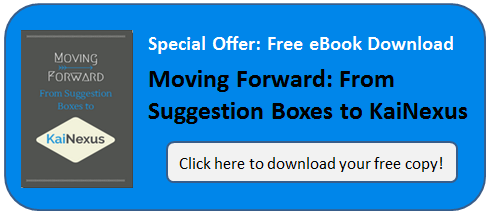 Suggestion boxes are a common, but ineffective, way to engage employees in continuous improvement. They’re usually implemented with the best of intentions by managers who genuinely want to hear their employees’ improvement ideas, but the boxes fail to produce the desired engagement.
Suggestion boxes are a common, but ineffective, way to engage employees in continuous improvement. They’re usually implemented with the best of intentions by managers who genuinely want to hear their employees’ improvement ideas, but the boxes fail to produce the desired engagement.
If you’ve tried to implement a suggestion box system in your organization before, it likely failed due to one of these reasons:
-
No followup
There’s a reason employees say that suggestion boxes are “where good ideas go to die.” Those boxes are black holes for employee creativity! Let’s say that you’re a front line employee, and you come up with a great idea to improve your work. Your only outlet for sharing that idea is the suggestion box on the wall outside your manager’s door. You give your idea lots of careful thought, write it down, and drop it into the box. What happens next?
You have no idea.
You don’t know when the box was opened. You don’t know when (or if) your boss read the idea. You don’t know if your idea has been sent to a committee for approval, tossed in the trash, or given to someone else to implement.
This lack of followup is the death knell for employee engagement. Employees aren’t going to exert discretionary effort sharing improvement ideas, if they don’t know what happens to them. -
Only implementing a small number of ideas
Did you know that only 2-3% of ideas in a typical suggestion box system are implemented? That’s a huge detractor for employee engagement. Why would employees bother giving you their ideas for improvement if nothing comes of them? Employees who identify opportunities for improvement do so because they’ve either found a problem that they want to fix or a way to make something better. If you don’t empower them to make those changes themselves, they’re going to stop looking for them. -
No recognition and reward
A great way to increase employee engagement in continuous improvement is to recognize people for their involvement. Employee recognition doesn’t need to be anything big or fancy - a pat on the back or a high five is enough to encourage the participating employee and promote the engagement of others. Suggestion boxes make this difficult, though, since there’s no public acknowledgement for submitted or implemented improvements. -
No way to promote engagement
There are several ways to promote the engagement of employees in continuous improvement, including to recognize and reward those who have participated already, broadcast improvements to share best practices, increasing visibility into improvement work to identify high- and under-performing areas, responding quickly to employee engagement, to name a few. Suggestion boxes certainly don’t help with any of these behaviors - and often, they directly interfere with them. Good luck spreading continuous improvement with a stagnant box on the wall. -
Doesn’t change behavior
if you’ve ever tried to spread a culture of continuous improvement, you know that a critical component of that is changing the daily behavior of employees and leaders. You want them constantly on the lookout for opportunities for improvement and continually making improvements to their daily work. A suggestion box isn’t going to do that. Maybe you can, if you’re persuasive in your barrage of nagging email reminders, but changing the behaviors of every person in your organization is a huge workload. Plus, it’s only a matter of time before everyone treats you like Pumba at the watering hole. -
No way to share improvements
The best way to spread continuous improvement in an organization is to broadcast improvements. Announcing the impact and recognizing the person who made the improvement encourages others to get involved, and sharing new best practices expands the reach of each idea. With a suggestion box, leaders have to take the time to notify all of the right people about new improvements. Busy managers don’t often take the time to reach out to individuals like that, so the improvements don’t spread. -
It’s hard for people to submit ideas
Imagine this scenario. You’re a busy front line worker, running around all day trying to get your work done. You have an idea for a way that would improve your work (and the work of everyone else performing your job function). Do you a) Stop working, write it on a slip of paper, run across the department, and drop it in a box, or b) Implement it in your own work... if you remember... maybe. If you’re like most people, you don’t go out of your way to submit ideas that likely won’t be followed up on anyway. If no one is submitting ideas into your suggestion box, your system is failing. - You thought making it digital would solve your problems
Taking a suggestion box and recreating it online only advances the idea if it is simultaneously transformed and improved. A digital box is slightly better than a physical box (better because you can put stuff in it from anywhere), but if the follow up process is the same, the results will be just as dismal. The problem with the suggestion box isn’t that it is a physical thing, but rather, that it provides no structure enabling ideas to be identified, implemented, measured, and broadcast. Unless the tool you’re putting the ideas into does that, your results will stay the same. -
No way to check out who it participating and who isn’t
If you’re trying to get employees to participate in continuous improvement, it’s important to know who is actually submitting and implementing ideas, right? That’s how you know who to recognize for their contributions, and who to track down for additional coaching. A pile of papers from a suggestion box won’t help with that, unless you’re willing to sort them by contributor (though I guess this wouldn’t be a hard task, since there likely are not many ideas in there anyway) and figure out who is missing from the pile. It’s pretty unlikely that your managers are going to take the time for that.
Suggestion boxes are a bad way to approach a great concept, and the desire to engage employees in continuous improvement shouldn’t be abandoned because that method failed. Instead, I’d encourage you to look into continuous improvement software. Continuous improvement software helps you collect the improvement ideas from your staff like a suggest box does, but provides a variety of features that fix all of the problems inherent in suggestion boxes. The impact of such software is the identification of more ideas, engagement of more employees, and implementation of more improvements. With continuous improvement software, you can accomplish everything you failed to achieve with your suggestion box. Learn more about continuous improvement software here.



Add a Comment